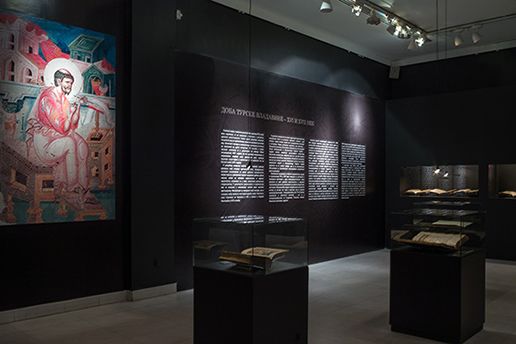At the representative exhibition that was opened on August 23 at the Gallery of the Serbian Academy of Sciences and Arts, a part of the Serbian manuscript heritage was presented from the oldest, completely preserved manuscripts from the late 12th century (Miroslav’s Gospel) to the late 17th century manuscripts. With its foundations that can be traced back to Byzantine origin, the Serbian art of writing had its expansion in the late Middle Ages and lasted until the dawn of the New Age. The exhibits that are displayed come from local collections, and partly from foreign collections, bearing in mind the fact that Serbian manuscript heritage has been dispersed across numerous world libraries and monasteries. Manuscripts written in Serbo-Slavonic: liturgical books richly decorated with miniatures, emblems and initials, theological literature and books that belong to the history of Byzantine philosophy, various translation literature as well as the copies with original literary works of old Serbian writers are displayed at the exhibition.
Among the exhibited manuscripts there are five manuscripts from the 14th and 15th century that particularly stand out and that are borrowed from the library of the Hilandar Monastery. Their rich illumination belongs to the most beautiful creations of book ornaments not only in medieval Serbia but in Byzantium as well. The significant segment of the exhibition are also the manuscripts belonging to the Archive of the Serbian Academy of Sciences and Arts: Mostar Gospel of Manojlo (the first third of the 14 century), Paraenesis from 1337, Four-Gospel Book of the Kumanica Monastery in which four miniatures of extraordinary beauty have been inserted, painted in the mid 14th century, and the transcript of the Code of Mines of Despot Stefan Lazarevic, which in 1580ies was written and illuminated by the well-known calligraphist Jovan the Serb of Kratovo.
The visitors of the exhibition shall have the opportunity to see also the stationary used in 16th and 17th century and also several books equipped with luxuriously gilt covers that provide insight into the development of the Serbian goldsmith craft of the post-Byzantine period.
The authors of the exhibition are Dr Zoran Rakic, an art historian, and Dr Irena Spadijer, a literary historian. The exhibition is accompanied by a comprehensive and richly illustrated study catalogue.
